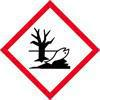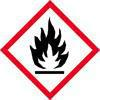Labelling of hazardous substances
Products containing hazardous substances have labels displaying hazard symbols and other warnings, so that shippers, handlers and customers are aware of the risks.
Consumer labels
Consumers also come into contact with products containing hazardous substances, such as cleaning agents. The packaging of these products must display a warning, possibly in the form of a symbol, and instructions on how to act in the event of direct contact with the substance.
Rules on labelling for transport
Things can go wrong when hazardous substances are being shipped. If there is an accident, emergency services and passers-by need to know what substances are involved. Shippers and producers must indicate this clearly using labels and hazard symbols.
The label may also give other information, such as that a product may only be transported in an aircraft’s cargo hold.
Examples of warning labels:
Hazardous to the aquatic environment
Flammable
Identifying hazardous substances
There is a worldwide system of hazard codes that is used to indicate the types of risk associated with a substance, for instance, whether it is a flammable liquid or a corrosive substance.
Shippers also use a number system (UN numbers) to identify the most commonly transported hazardous substances. These UN numbers are shown on the packaging of hazardous substances. When they are transported by rail or road, the number is also shown on the wagon or tanker.
Regulation of labelling
The following organisations regulate the labelling of hazardous substances:
- the Dutch Food and Consumer Product Safety Authority is responsible for the labelling of foods and non-foods (such as household chemicals and detergents);
- the Human Environment and Transport Inspectorate is responsible for the rules on labelling and hazard symbols for the transportation of hazardous substances.

